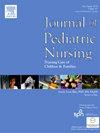Association between psychosocial barriers, family-centered care, and caregiver presence at the bedside in a pediatric post-acute care hospital: A qualitative study
IF 2.3
4区 医学
Q2 NURSING
Journal of Pediatric Nursing-Nursing Care of Children & Families
Pub Date : 2025-05-01
DOI:10.1016/j.pedn.2025.03.023
引用次数: 0
Abstract
Purpose
Children with medical complexities are often in need of prolonged admissions to post-acute care hospitals. Caregiver presence at the bedside has been associated with improved outcomes for pediatric patients and caregivers. Ecological barriers have been found to impact caregiver presence at the bedside during pediatric admissions. While caregiver mood, coping, and family-centered care have been associated with caregiver presence in neonatal and pediatric intensive care units, less is known about post-acute admissions. The present qualitative study explored caregivers' psychosocial barriers to presence at the bedside and the role of family-centered care in a pediatric post-acute care hospital.
Design and methods
Semi-structured interviews were completed by a convenience sample of 10 self-identified caregivers of children admitted to post-acute care. Data was analyzed through a deductive content analysis process.
Results
Four key themes emerged: ecological barriers to caregiver presence at the bedside, leading to difficult decision-making needs; pediatric admissions and decision-making impact caregiver mood; utilization of meaning-centered, action-oriented, and social coping; and family-centered care as a facilitator of presence and reduction of burden.
Conclusions
Barriers to presence at the bedside seem to increase existing caregiver distress and burden. The role of family-centered care, namely hospital support and caregiver-staff collaboration, serves as a moderator between psychosocial barriers and presence at the bedside.
Practice implications
Targeted training in family-centered care for nurses and other providers involved in the day-to-day management of patients and caregivers is warranted to increase visitation rates and improve the mental health of caregivers during pediatric post-acute care admissions.
儿童急症后护理医院的心理社会障碍、以家庭为中心的护理和护理人员在床边的存在之间的关系:一项定性研究
目的:患有医疗并发症的儿童往往需要在急性后护理医院延长住院时间。护理人员在床边的存在与儿科患者和护理人员的改善结果有关。在儿科住院期间,生态障碍已被发现影响护理人员在床边的存在。虽然护理人员的情绪、应对和以家庭为中心的护理与新生儿和儿科重症监护室护理人员的存在有关,但对急性后入院的了解较少。本定性研究探讨了护理人员在床边的心理障碍和以家庭为中心的护理在儿科急症后护理医院的作用。设计与方法半结构化访谈由10名自认为是急症后护理儿童的护理人员组成的方便样本完成。数据通过演绎内容分析过程进行分析。结果出现了四个关键主题:护理人员在床边存在的生态障碍,导致难以做出决策需求;儿科入院和决策影响看护者情绪;以意义为中心、以行动为导向和社会应对的运用以及以家庭为中心的护理作为在场和减轻负担的促进者。结论床边障碍似乎增加了现有照顾者的痛苦和负担。以家庭为中心的护理的作用,即医院支持和护理人员与工作人员的协作,在心理社会障碍和临床之间起到调节作用。实践意义:有必要对护士和其他参与患者和护理人员日常管理的提供者进行以家庭为中心的护理培训,以提高儿童急症后护理住院期间的探视率和改善护理人员的心理健康。
本文章由计算机程序翻译,如有差异,请以英文原文为准。
求助全文
约1分钟内获得全文
求助全文
来源期刊

Journal of Pediatric Nursing-Nursing Care of Children & Families
NURSING-PEDIATRICS
CiteScore
3.70
自引率
8.30%
发文量
291
审稿时长
65 days
期刊介绍:
Official Journal of the Society of Pediatric Nurses and the Pediatric Endocrinology Nursing Society (PENS)
The Journal of Pediatric Nursing: Nursing Care of Children and Families (JPN) is interested in publishing evidence-based practice, quality improvement, theory, and research papers on a variety of topics from US and international authors. JPN is the official journal of the Society of Pediatric Nurses and the Pediatric Endocrinology Nursing Society. Cecily L. Betz, PhD, RN, FAAN is the Founder and Editor in Chief.
Journal content covers the life span from birth to adolescence. Submissions should be pertinent to the nursing care needs of healthy and ill infants, children, and adolescents, addressing their biopsychosocial needs. JPN also features the following regular columns for which authors may submit brief papers: Hot Topics and Technology.
 求助内容:
求助内容: 应助结果提醒方式:
应助结果提醒方式:


